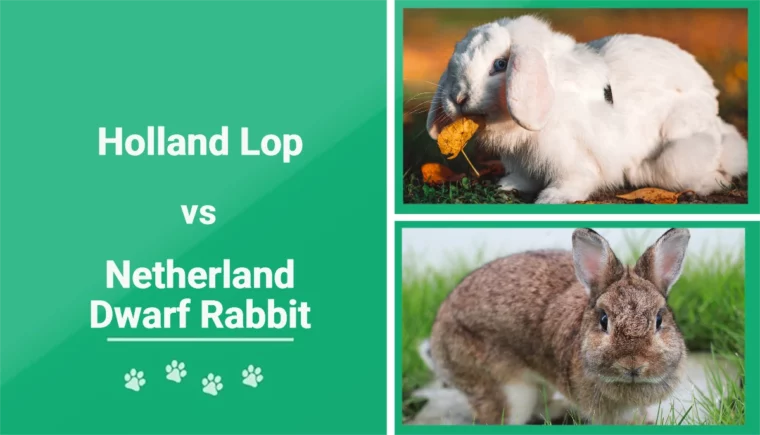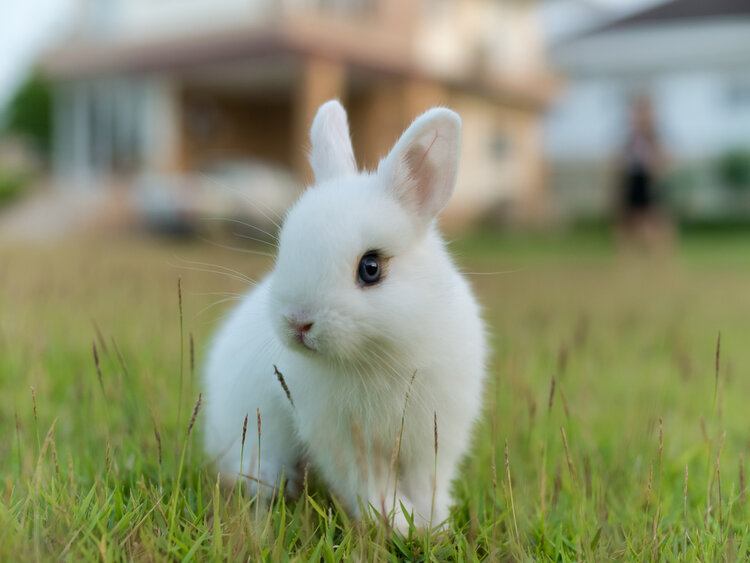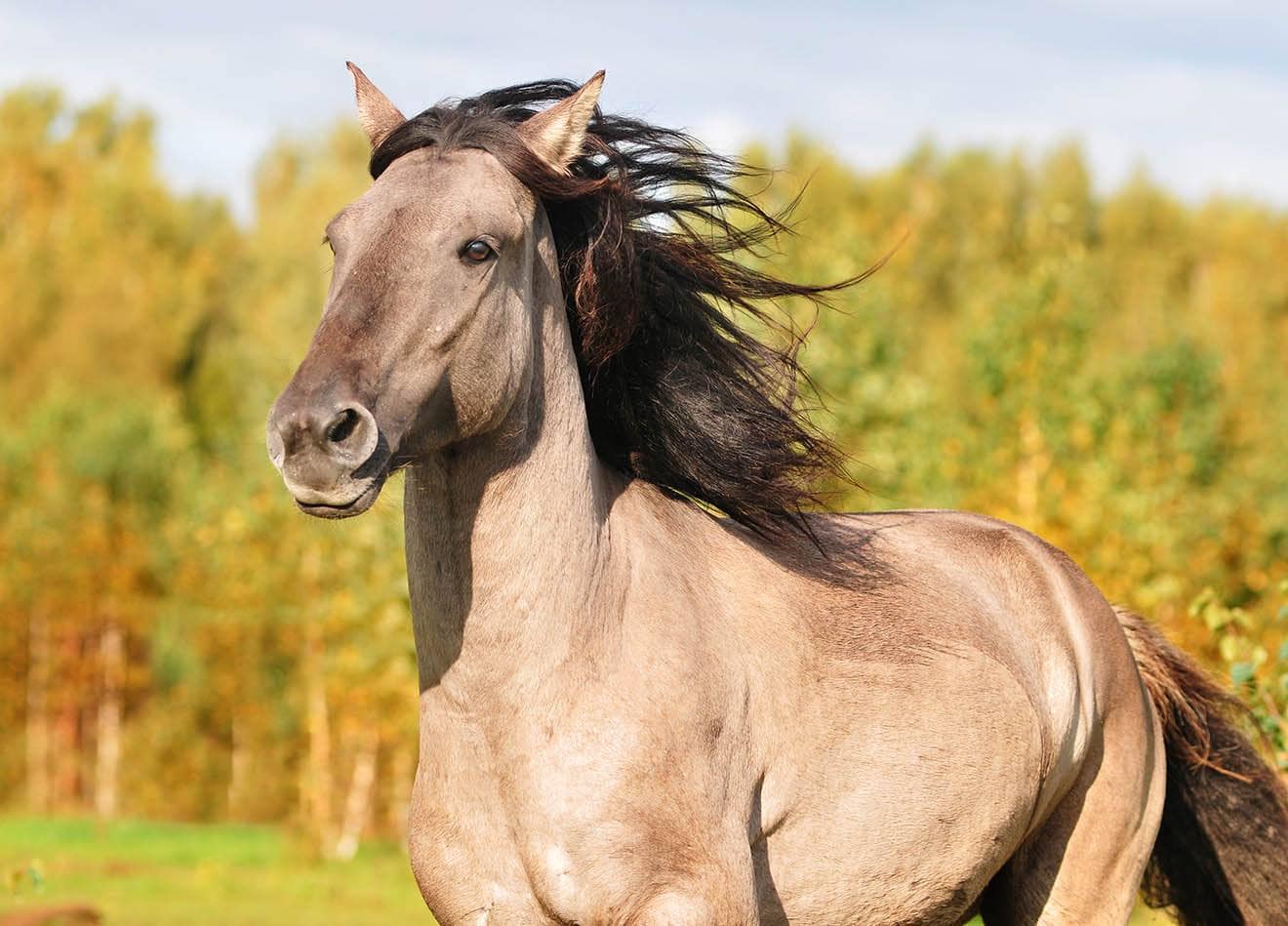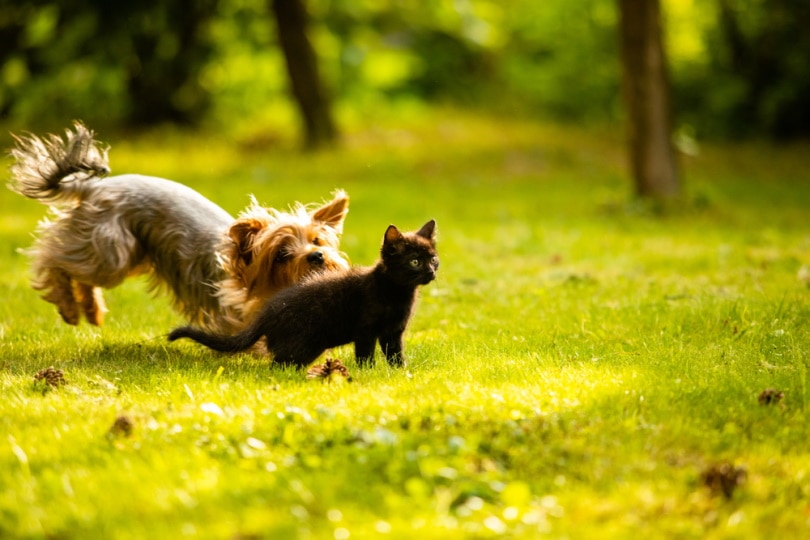
Click to Skip Ahead
When you’re buying a bunny, it might be hard to pick a specific breed out of a lineup. Rabbits come in all sorts of looks, sizes, and colors. The Holland Lop and the Netherland Dwarf are both perfect pets for the right owners. So, you might have some trouble picking which of these cuties will come home with you.
Here, we will discuss a breakdown of each of these rabbits’ personality tendencies, care, and health concerns. You can see which one catches your eye the most. Will you choose the floppy-eared, smoosh-faced Holland Lop or the short-eared itty-bitty Netherland Dwarf?
Visual Differences

At a Glance
Holland Lop Overview

History
The Holland Lop breed originated in the Netherlands and was recognized by American Rabbit Breeders Association in 1979. These bunnies are famous for their adorably floppy ears and soft coats.
Personality
Many owners appreciate Holland Lops because they are extra sweet and agreeable. They make terrific playmates for other bunnies and do well in social settings.
Many parents choose the Holland Lop for children because of their docile demeanor. They tend to be much calmer and less inclined to kick or bite than some other rabbits.
They also typically lack the high-strung, semi-nervous attitude of some bunnies. Males tend to be a little friendlier and easier to handle than females.
Exercise
Holland Lops require time out of the cage every day. Let them out to play for as long as they’re burning energy. Some rabbits will hop around for a long time, while others will let you know when they’re ready to go back inside their home.
Training
Like cats, you can potty train rabbits. It makes cleaning super easy and keeps their cage in better condition. Once you have a bunny litter trained, you even have the option to let them run loose—with supervision, of course.
Health & Care
Like anything else, Holland Lops are prone to certain health conditions over others. Proper veterinary care eliminates certain risk factors so you can keep up on your bunny’s overall health.
Some common health issues seen in Holland Lops are:
Your little Lop should visit the vet annually for routine examinations—even if they don’t show signs of anything.

Breeding
It’s best for both male and female Holland Lops to be 6 months or older before starting the breeding process. Once they are old enough, you should start breeding as soon as possible and stop entirely by the second year.
Cage Size
A Holland Lop requires at least 24 square inches of singular-level cage space. These bunnies aren’t the most high-energy rabbits, but they still need adequate space.
Suitable for:
Holland Lops are great additions to practically any bunny-loving home. They’re one of the best bunnies you can get for children since they are so calm and even-keeled.
Netherland Dwarf Overview

History
As the name implies, the Netherland Dwarf heralds from the Netherlands. They are one of the smallest rabbit breeds of all, with short ears and brachycephalic heads. The American Rabbit Breeders Association first recognized them in 1969.
Personality
You might want to be a little seasoned before opting for a spunky Netherland Dwarf. These rabbits are a bit on the frisky side—some would even stay skittish or moody.
They might look cute and cuddly, but this breed doesn’t enjoy a lot of handling. Their attitudes can be entertaining for some owners, so they make ideal pets for the right households.
Early handling is essential to tame this bunny. Even a Netherland Dwarf that had a lot of attention as a baby might still be a bit timid or grumpy.
Exercise
Like all other bunnies, the Netherland Dwarf needs a bit of time out of the cage. You can get them out at least once a day so they can burn off some steam. Let them hop around in a supervised space, but keep your eye on them. These rabbits are small and slippery sometimes, so they can be hard to find.
Training
Because Netherland Dwarfs aren’t as interactive as some other breeds, they can be more challenging to train. With frequent handling and socialization, you might be able to train your rabbit to use the litter box.
Health & Care
Netherland Dwarfs don’t come problem-free. Specific ailments show up in this breed of rabbit more often than others.
Some issues are:
At annual vet visits, exams can detect any early problems.

Breeding
If you have two healthy bunnies and want to try breeding, you need to make sure the conditions are right. As with other rabbits, you need to wait until they reach about 6 months, which is when they’re sexually mature.
Cage Size
For your Netherland Dwarf to thrive, they need a singular-level cage that’s at least 18 x 24 inches.
Suitable for:
Netherland Dwarfs are best for people who don’t have strict expectations on how their bunny should behave. These bunnies tend to be a bit spirited and less interactive than some other breeds. If you want a rabbit who has a spitfire personality but is less snuggly, then you will adore the Netherland Dwarf.
Guide to Bunny-Owning
It’s a good idea to pick out the bunny that stands out most to you. But remember—not everything is about looks. You might be new to the species, so you think all rabbits are cute and cuddly. As we discussed, the Holland Lop is much more receptive to attention than the Netherland Dwarf.
It would be best if you always bought a pet that you can care for. After all, they will rely on you for all care needs, and you should have a rewarding relationship that you prepare for in advance.
Beginners or First-Time Owners
If you are just starting, you might wonder which bunny is your best bet. You can handle either since their care is very similar. However, if you haven’t had a lot of experience or this is your first pet, a Holland Lop might be more agreeable and easier to bond with.
Appropriate Age for Bunnies
You should always make sure your child is ready for the commitment of having a bunny. By age six, most children can comprehend appropriate handling and primary care. They will still need some help, though.
Rescuing vs. Buying
When you decide you want a rabbit, you can look in a few places for the right one.
You can look for a bunny from:
No matter how you find your bunny, make sure that you have a healthy little guy or gal, and don’t skip vet check-ups.
Which Rabbit Is Right for You?
When you finally decide between the Holland Lop and Netherland Dwarf, consider all the factors. Both of these bunnies need specialized care specific to their breed. Remember that both of these cuties require similar cage sizes, diet, and socialization.
However, the Holland Lop is better for beginners, while Netherland Dwarfs might be best for experienced owners. Of course, if you decide to get a Netherland Dwarf as your first rabbit, make sure to spend lots of time with them early to form the best relationship possible.
Featured Image Credit: Top – Ali Atakan Açıkbaş, Pexels| Bottom – CART00N, Shutterstock









